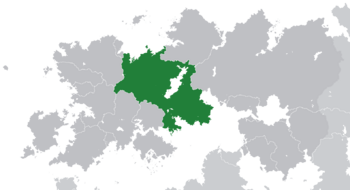Tervingia: Difference between revisions
Jump to navigation
Jump to search
No edit summary |
mNo edit summary |
||
| Line 1: | Line 1: | ||
{{wip}} | {{wip}} | ||
{{Region_icon_Ajax}} | |||
{{Infobox former country | {{Infobox former country | ||
| conventional_long_name = Tervingian High Kingdom | | conventional_long_name = Tervingian High Kingdom | ||
| Line 131: | Line 132: | ||
}} | }} | ||
'''Tervingia''' was a major {{wp|West Goths|Gothic}} {{wp|Polity|political state}} and {{wp|Hegemony|cultural power}} in [[Ajax#Belisaria|eastern Belisaria]] which existed from 323 BCE to its dissolution in 429 CE. | |||
[[Category:Belisaria]] [[Category:Ostrozava]] [[Category:Drevstran]] [[Category: | |||
==See also== | |||
* [[Alban Pentapolis]] | |||
* [[Azdraï|Kingdom of Azdraï]] | |||
* [[Latium#Imperial_era|History of the Latin Empire § Northeastern expansion]] | |||
* [[Drevstran|History of Drevstran]] | |||
[[Category:Belisaria]] | |||
[[Category:Ostrozava]] | |||
[[Category:Drevstran]] | |||
[[Category:Latium]] | |||
[[Category:Garima]] | |||
[[Category:Nachtmark]] | |||
[[Category:Besmanien]] | |||
[[Category:History]] | |||
Revision as of 22:04, 30 April 2020
This article is incomplete because it is pending further input from participants, or it is a work-in-progress by one author. Please comment on this article's talk page to share your input, comments and questions. Note: To contribute to this article, you may need to seek help from the author(s) of this page. |
Tervingian High Kingdom
| |||||||||||||||
|---|---|---|---|---|---|---|---|---|---|---|---|---|---|---|---|
| 323 BCE–429 CE | |||||||||||||||
 Largest extent of Tervingia, c. 220 CE | |||||||||||||||
| Status | Dissolved | ||||||||||||||
| Capital | Saragetra | ||||||||||||||
| Religion |
| ||||||||||||||
| Demonym(s) | Tervingian, Gothic | ||||||||||||||
| Government | Empire | ||||||||||||||
| History | |||||||||||||||
• Established | 323 BCE | ||||||||||||||
• Dissolution | 429 CE | ||||||||||||||
| |||||||||||||||
Tervingia was a major Gothic political state and cultural power in eastern Belisaria which existed from 323 BCE to its dissolution in 429 CE.
